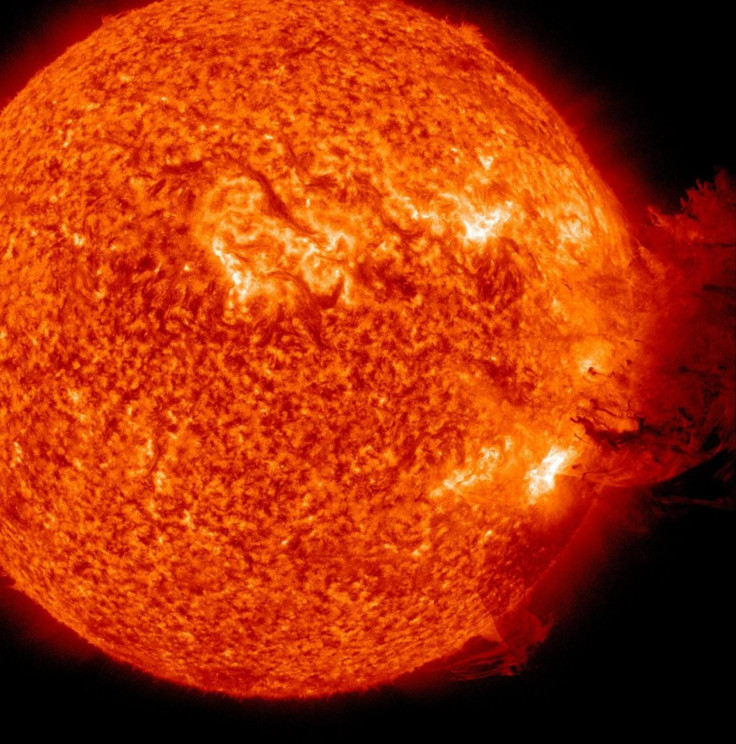Solar Tsunami Heading Earth's Way; Auroras to be Visible on Thursday

A solar flare that erupted on Tuesday in the Sun is heading towards the Earth and could disrupt power grids and satellites. The flare, which is backed by a small radiation storm and a spectacular coronal mass ejection (CME), might stimulate auroras on Thursday.
National Aeronautics and Space Administration’s (NASA) solar dynamics observatory (SDO) observed the solar flare peaking at 1:41 am ET on Tuesday. The solar flare was termed as M-2 (medium-sized), while the radiation storm considered as an S1-class (minor).
The flare is moving away from the sun at 1400 km/s. This flare was a different kind because it started out slow, then the sun blasted it off like a volcanic eruption. The large cloud of particles mushroomed up and fell back down looking as if it covered an area of almost half the solar surface, NASA said in a statement.
SDO's images show a very large eruption of cool gas. It is somewhat unique as at many places in the eruption there seems to be even cooler material -- at temperatures less than 80,000 degrees Kelvin.
NASA said the CME should deliver a glancing blow to Earth's magnetic field during the late hours of June 8 or June 9.
Earlier, the National Oceanic and Atmospheric Administration's (NOAA) space weather prediction center expected the flare to cause G1 (minor) to G2 (moderate) levels of geomagnetic storm activity Wednesday, June 8, beginning around 1800 UTC (1 pm EST) with the passage of a fast CME. But the center revised its prediction for Geomagnetic Storm activity, now expecting the CME to pass Earth around 1200 UTC (7 pm EST) on June 9.
Earlier, the center said a prompt Solar Radiation Storm reached the S1 (minor) level soon after the impulsive R1 (minor) Radio Blackout at 0641 UTC. The Solar Radiation Storm includes a significant contribution of high energy (>100 MeV) protons, the first such occurrence of an event of that type since December 2006.
But the center revised its prediction, and now expects primarily G1 (minor) NOAA Scale levels, and for the storm to persist for 24 hours. The intensity of the Solar Radiation Storm is expected to be little affected by the passage of the CME-driven shock.
Auroras can be spotted throughout the world and on other planets. They are most visible closer to the poles due to the longer periods of darkness and the magnetic field. Auroras are more frequent and brighter during the intense phase of the solar cycle when coronal mass ejections increase the intensity of the solar wind.
A solar flare is an explosion on the Sun that happens when energy stored in twisted magnetic fields, usually above sunspots, is suddenly released. Flares produce a burst of radiation across the electromagnetic spectrum, from radio waves to x-rays and gamma-rays. The amount of energy released is the equivalent of millions of 100-megaton hydrogen bombs exploding at the same time.
NOAA space weather prediction center issued a 3-day solar-activity forecast on June 7 at 10:00 pm UTC, where solar activity is expected to be at very low levels with a chance for C-class events for the next three days (June 8 to 10).
In the geophysical-activity forecast, the center expects the geomagnetic field to be mostly quiet on Wednesday and on the beginning of Thursday. Midday on June 9, active to minor storm levels are expected as the CME associated with today's solar flare becomes geoeffective, it said.
With the arrival of this CME, there is a slight chance for major storm periods at high latitudes. On June 10, as the effects of the CME continue, active levels, with chance for minor storm periods, are also expected, the center said.
© Copyright IBTimes 2024. All rights reserved.











